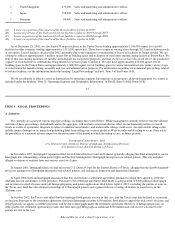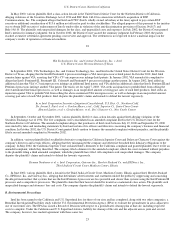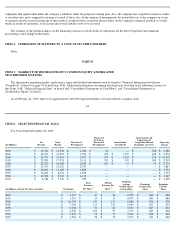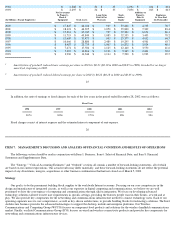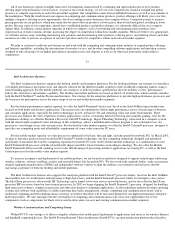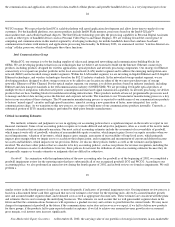Intel 2002 Annual Report Download - page 30
Download and view the complete annual report
Please find page 30 of the 2002 Intel annual report below. You can navigate through the pages in the report by either clicking on the pages listed below, or by using the keyword search tool below to find specific information within the annual report.
For 2002, net losses on equity securities and certain equity derivatives were $372 million compared to $466 million for 2001. The net loss
for 2002 consisted of impairment charges, primarily of non-marketable equity securities, of approximately $524 million, partially offset by net
gains of approximately $57 million related to equity trading assets and $110 million of net gains on related equity derivatives. The $57 million
net gains included a gain of $120 million, resulting from the designation of formerly restricted equity investments as trading assets as they
became marketable. The cumulative difference between their cost and fair market value at the time they became marketable was recorded as a
gain in 2002. For 2001, the net loss included impairments of $1.1 billion, partially offset by net gains on transactions of $517 million and mark-
to-market gains on trading assets and derivatives of $122 million. The decrease to a net loss of $466 million in 2001 from a net gain of
$3.8 billion in 2000 was primarily due to impairments in 2001 compared to gains on sales of appreciated securities in 2000, including a
significant gain on the sale of our holdings of Micron Technology, Inc.
Interest and other, net decreased to $194 million in 2002 compared to $393 million in 2001. Interest income was significantly lower in
2002, primarily as a result of lower average interest rates. The difference in interest income between 2002 and 2001 was partially offset by the
impact of an impairment charge in 2001 on the company's equity-method investment in Convera Corporation. For 2001 compared to 2000,
interest and other, net decreased $594 million due to lower average investment balances and lower interest rates in 2001 compared to 2000, as
well as the impact of the Convera impairment charge in 2001.
Our effective income tax rate was 25.9% in 2002, 40.9% in 2001 and 30.4% in 2000. The decrease in the effective rate in 2002 is primarily
attributed to a decrease in non-deductible acquisition-related costs, including amortization of goodwill, and tax benefits related to divestitures
during 2002, partially offset by a greater portion of our profits being generated in higher tax jurisdictions. The increase in the effective rate in
2001 compared to 2000 is attributed to an increase in non-deductible acquisition-related costs during 2001, partially offset by a $100 million tax
benefit related to export sales and a greater portion of our profits generated in lower tax jurisdictions. The effective rate in 2000 benefited from a
reversal of previously accrued taxes of $600 million due to resolution of various tax issues. See "Outlook" for a discussion of our income tax rate
expectations.
Purchased In-Process Research and Development
During 2002, there were no acquisitions with significant IPR&D. IPR&D increased $89 million to $198 million in 2001 from $109 million
in 2000. The following table summarizes the significant assumptions underlying the valuations related to IPR&D from major companies
acquired at the time of acquisition in fiscal
35
2001 and 2000. We believe that the amounts determined for IPR&D represented fair value and did not exceed the amounts an independent party
would have paid for these projects at the time of acquisition.
Included below are further details regarding the technology acquired in these transactions.
2001 Acquisitions. In March, we acquired Xircom, which specialized in PC cards and other products used to connect mobile computing
devices to corporate networks and the Internet. Xircom had 20 IPR&D projects, each contributing from 1% to 24% of the total IPR&D value.
The in-process projects included the development of next-generation PC card devices for portable computing connectivity that support various
computing standards. These projects ranged from 5% to 86% complete. All projects had expected completion dates in 2001 at the time of
acquisition. Expected completion dates for three projects representing 30% of the total IPR&D value were revised to 2002 with one being
completed in 2002. The remaining two projects representing 29% of the total IPR&D value have revised completion dates in early 2003. Nine
additional projects representing 33% of the total IPR&D value were cancelled in 2001 in order to focus on strategic projects, including the next
generation of current products. Xircom's remaining projects were completed as scheduled.
In April, we acquired VxTel, which designed signal and packet processing silicon and system-level solutions that form the foundation for
next
-
generation optical networks. VxTel had two IPR&D projects, with its digital signal processor project accounting for 89% of the total
Interest and other, net
$
194
$
393
$
987
Provision for taxes
$
1,087
$
892
$
4,606
(Dollars in Millions)
IPR&D
Estimated Cost to
Complete
Technology
Discount Rate
Applied to
IPR&D
Weighted
Average Cost
of Capital
2001
Xircom, Inc.
$
53
$
7
25
–
55
%
22
%
VxTel Inc.
$
68
$
14
25
–
35
%
22
%
LightLogic, Inc.
$
46
$
7
25
–
35
%
23
%
2000
GIGA A/S
$
52
$
12
20
%
15
%


